In the following post, I note the distinguishing characteristics of Ohio’s turtle species, plus the counties in which they’ve been sighted.
Family Emydidae
Midland Painted Turtle (Chrysemys picta marginata)
If you’ve seen a turtle basking in the sun in Ohio, and you’re wondering what kind of turtle it is, the odds are that it’s a Midland Painted Turtle.
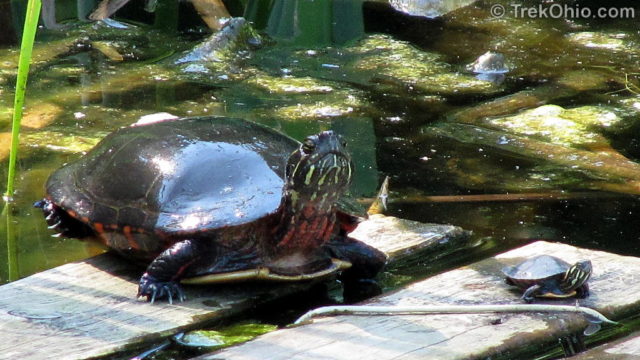
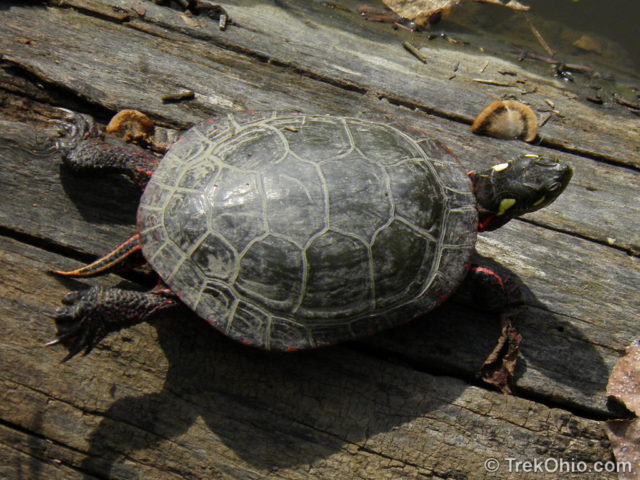

This is one of the most common turtles in Ohio, plus it’s easy to spot because it enjoys basking on logs or other objects near the water’s surface. To make it even more noticeable, it often basks in groups.
The carapace (upper shell) of the Midland Painted Turtle reaches between 4.5 and 5.5 inches in length, and it’s very dark green (nearly black). The turtle gets it’s “painted” characteristic from the bright red markings along the outer edge of its shell. The head typically has yellow stripes which may become red near the shell. The legs may also have red stripes.
Since 1976 Midland Painted Turtles have been sighted in the following Ohio counties: Adams, Ashtabula, Athens, Belmont, Brown, Butler, Champaign, Clark, Darke, Delaware, Geaugua, Guernsey, Hamilton, Knox, Lake, Licking, Lorain, Lucas, Marion, Medina, Miami, Morrow, Ottawa, Pickaway, Pike, Portage, Preble, Summit, Trumbull, Vinton, Wayne, Williams. Prior to 1976 the turtle was sighted in additional counties.
For more information, check out this Wikipedia page on Painted Turtles. Although this Wikipedia articles discusses several varieties of painted turtle, only the Midland Painted Turtle lives in Ohio.
Red-eared Slider (Trachemys scripta elegans)
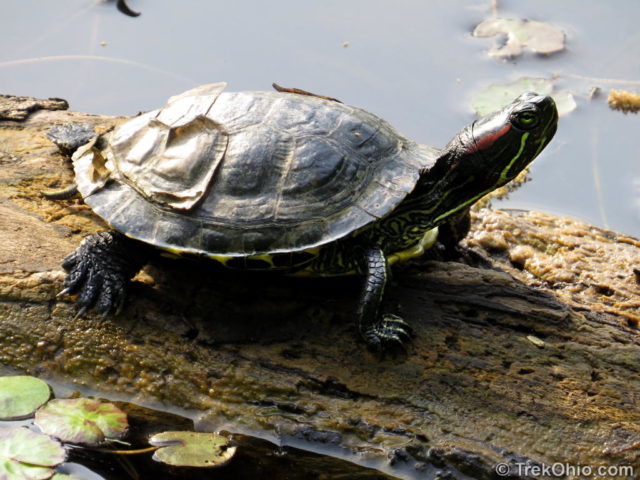
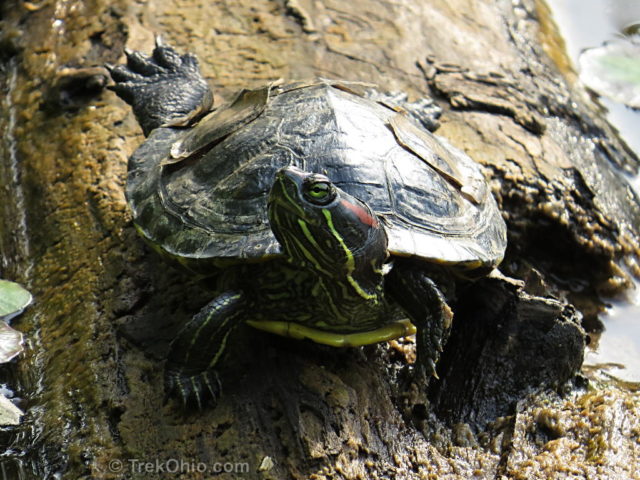
The carapace (upper shell) of the Red-eared Slider reaches 5 to 8 inches in length. Although the yellowish lines found on our Midland Painted Turtle may turn reddish near the shell and be mistaken for a “red ear”, here are a couple of things to keep in mind to distinguish the two. The carapace of a Midland Painted Turtle is an almost uniform, dark color with red spots around the edge (when seen from above). But the carapace of the Red-eared slider is lighter, and more variable in color with lighter brownish green areas and no red spots around its edge. If you look at the limbs of a Midland Painted Turtle, you’ll note that there is typically some red on the turtles legs. This is not true of the Red-eared Slider. And finally if you note the counties where the two species have been seen, you’ll see that the distribution of the Midland Painted Turtle is much more wide in Ohio.
The Red-eared Slider is a native to the Southern United States. It is believed that the ones found in Ohio are the offspring of pets that were released into the wild. Doing this is a really bad idea. In California where the Red-eared Slider was released, it is in the process of out-competing the native western pond turtle.
Since 1976 Red-eared Slider Turtles have been sighted in the following Ohio counties: Butler, Greene, Hamilton, Licking, Mahoning, Pickaway, Summit.
For more information, check out the Wikipedia page on Red-eared Slider Turtle.
Spotted Turtle (Clemmys guttata)
The carapace (upper shell) of these turtles is usually between 3 and 4.7 inches. The background color of the shell varies from black to a bluish-black. The shell is sprinkled with yellow dots. It prefers to live in shallow wetlands and small streams, but may also be found in wet prairies and woods.
Since 1976 Spotted Turtles have been sighted in the following Ohio counties: Ashtabula, Clark, Cuyahoga, Greene, Hardin, Lucas, Ross, Trumbull, Warren. Their historic range included additional counties.
For more information, check out its Wikipedia page.
Wood Turtle (Clemmys insculpta)
If you see a wild turtle in Ohio, it’s probably not this species. Apparently a few specimens have been seen in northeastern Ohio, but we’re on the fringe of its range.
The carapace (upper shell) ranges from 6.3 to 9.8 inches long and is brown to grayish-brown in color. The head is black (it may or may not have spots on it). The throat may have a yellow, orange or red tint. They may be found in diverse habitats, but they prefer moving water with sand or gravel bottoms.
For more information, check out its entry in the University of Michigan’s Critter Catalog.
Eastern Box Turtle (Terrapene carolina carolina)
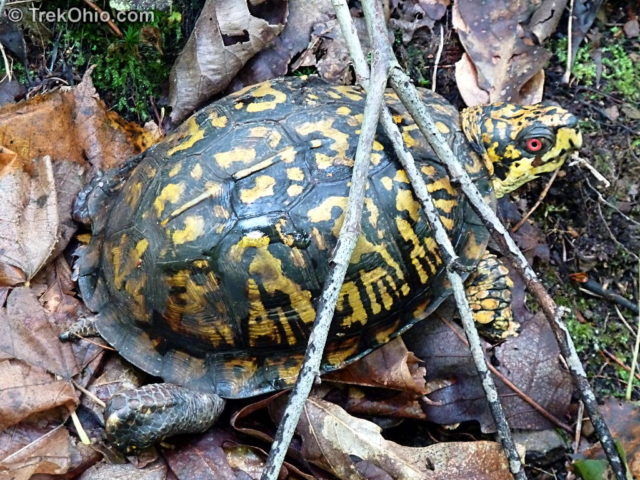
The carapace (upper shell) has a very high dome and reaches between 4.5 and 6 inches in length. The color of the upper shell varies; the background color it typically brown to black with yellow markings. The plastron (lower shell) has hinges in the front and back which allows the turtle to completely withdraw into its shell and shut the doors behind it. The ability to close itself within its “box” is how it got its name.
This is Ohio’s most terrestrial turtle which puts it at risk of being hit by cars as it tries to make its way slowing across a road. If it manages to avoid this fate, it is a very slow-maturing, but long-lived turtle. In the wild it can reach 100 years of age.
During the summer it keeps cool during the day by hiding in the shade or burrowing into leaf litter. It’s most active early in the morning and in the evening. If we’ve been having a dry spell, a rainy day will bring it out.
Since 1976 Spotted Turtles have been sighted in the following Ohio counties: Adams, Athens, Belmont, Butler, Clermont, Clinton, Cuyahoga, Erie, Franklin, Gallia, Greene, Guernsey, Jackson, Hamilton, Hocking, Knox, Meigs, Monroe, Montgomery, Morgan, Pickaway, Pike, Preble, Ross, Scioto, Vinton, Warren, Washington. Their historic range included additional counties.
For more information, check out its Wikipedia page.
Blanding’s Turtle (Emydoidea blandingii)
According to Wikipedia, the carapace (upper shell) ranges from 7.1 to 9.1 inches, but the Ohio Division of Wildlife says it ranges from 5 to 7 inches. Like the Eastern Box Turtle described above, the plastron (lower shell) has hinges in front and back, but the front hinge doesn’t work as well, so the Blanding’s Turtle can’t close up the front of its shell completely. The carapace has a dark background color with yellow specks. One of its most notable features is its yellow chin and throat.
In Ohio, Blanding’s Turtle is found in wetlands near Lake Erie. Occasionally it is seen walking overland from one wetland to another. Since 1976 it has been found in these Ohio counties: Cuyahoga, Erie, Lucas, Ottawa. In historic times it has been found in additional counties in Ohio’s northernmost regions.
Ohio Division of Wildlife video: Tracking the Secretive Blanding’s Turtle
For more information, check out its Wikipedia page.
Common Map Turtle (Graptemys geographica)
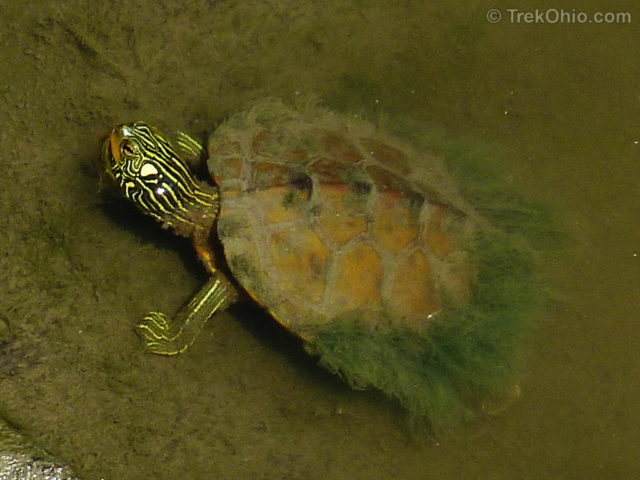
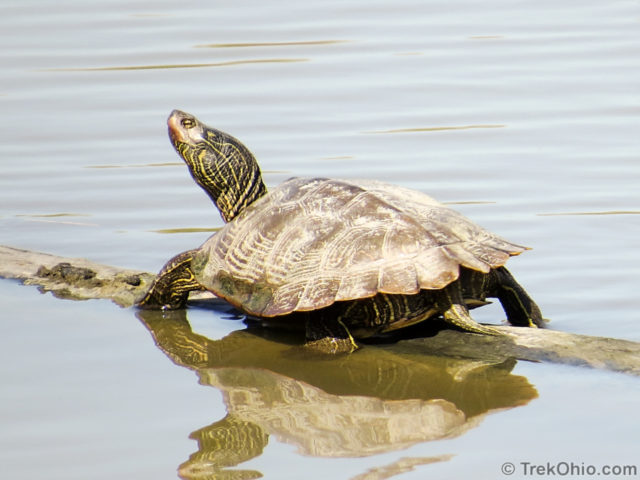
The female attains a length that’s about twice as big as the male. The carapace (upper shell) of the female gets to be about 10 inches long, while the male only makes it to about 5 inches. One very notable feature of the carapace is that there is a ridge running along the back from neck to tail. They are called “map” turtles because there are yellow lines on its back that are similar to those found on topographical maps. These lines are pronounced when the turtle is young, but they tend to fade away as the turtle grows older. The heads and limbs have yellow stripes.
These turtles like deep water, so they are typically found in lakes and large rivers. They are very wary about people and will quickly slip away into deeper water if a person draws close. They are the least likely turtle to be hibernating in the winter and have been spotted walking around under the ice.
Since 1976 Spotted Turtles have been sighted in the following Ohio counties: Adams, Columbiana, Marion, Ottawa, Pickaway, Williams. Their historic range included additional counties, such as Delaware where I photographed the turtle with algae on its back seen above.
For more information, check out its Wikipedia page.
Ouachita Map Turtle (Graptemys ouachitensis)
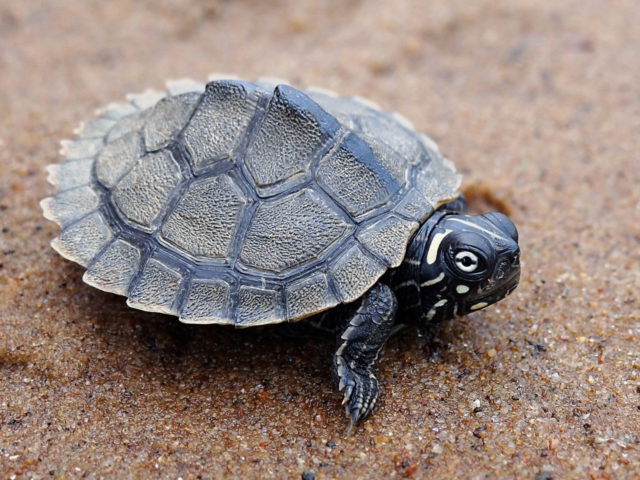
Ouachita Map Turtle (Graptemys ouachitensis); note the spines on the ridge of the back. Also note the yellow dot under each eye and on each side of the jaw.
Like the Common Map Turtle, the female Ouachita Map Turtle grows much larger than the male. The carapace (upper shell) of the female can reach a length of 10.75 inches while the male’s carapace reaches a length of 5.75 inches. Also like the Common Map Turtle there is a yellow blob behind each eye. Unlike the Common Map Turtle, the Ouachita Map Turtle also has a yellow blob under each eye and on each side of its jaw. The two species of map turtle are also similar in that both species have a ridge on their carapaces that runs from neck to tail. However this ridge is somewhat different in the Ouachita Map turtle because its ridge has spines.
Since 1976 Ouachita Map Turtles have been sighted in the following Ohio counties: Pickaway and Ross.
For more information, check out its Wikipedia page.
Family Chelydridae
Snapping Turtle (Chelydra serpentina)
This is Ohio’s largest turtle. The carapace (upper shell) typically ranges in size between 10 and 19 inches, and these turtles usually weigh between 10 and 35 pounds. They are very aggressive if approached when they are outside of the water, and they have very powerful jaws. Unlike many turtles, about the only time they bask is at the very beginning of spring.
The turtle below has pulled his head in as much as possible.
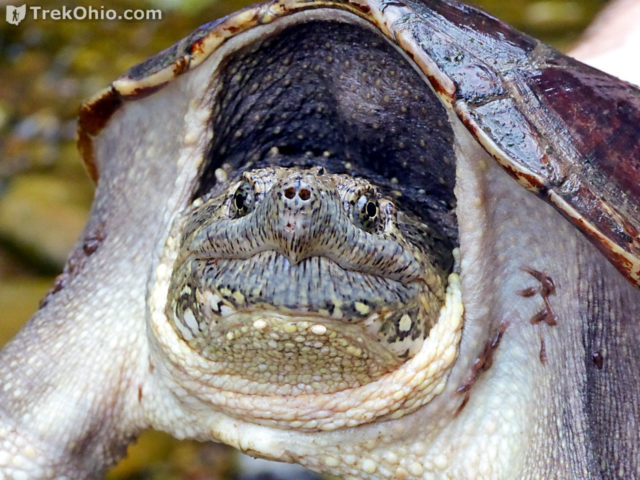
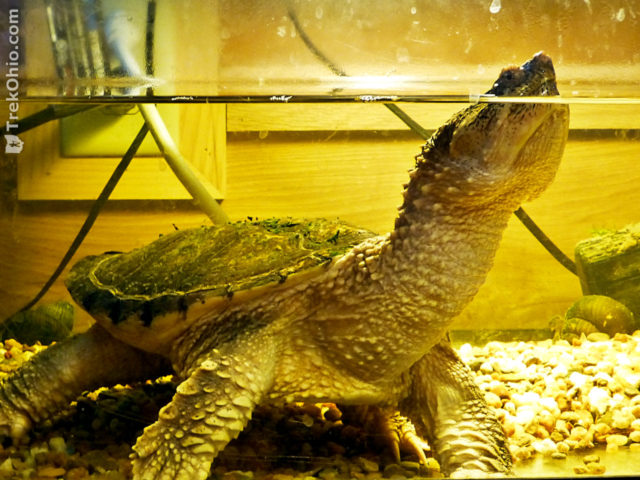
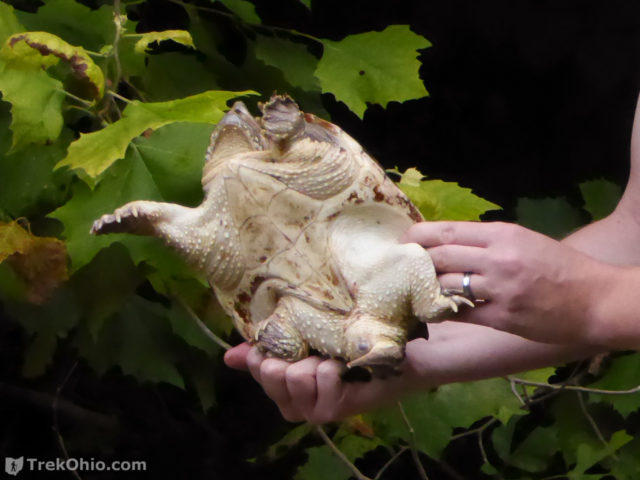
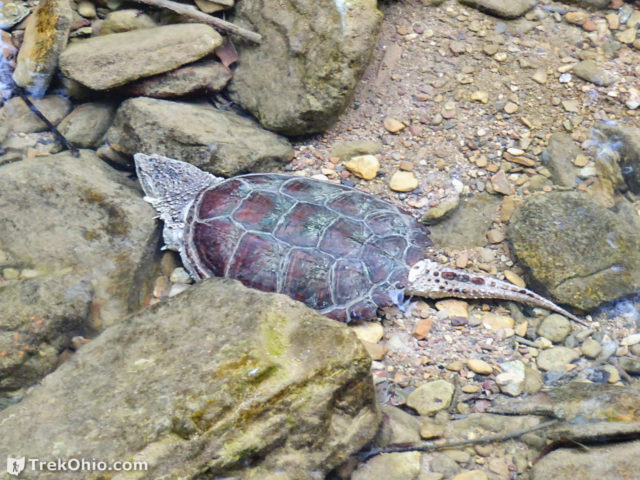
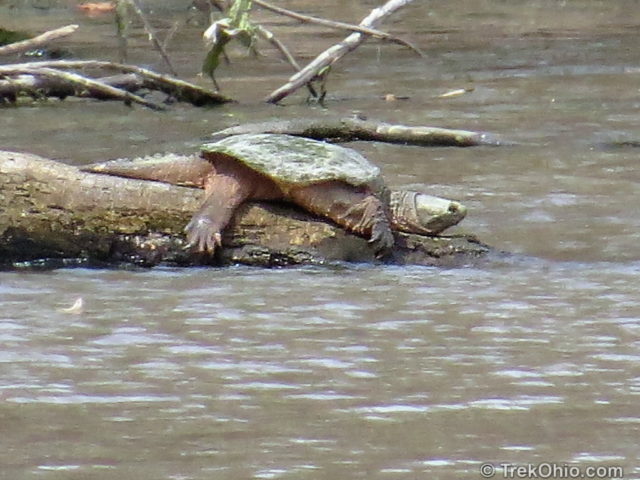
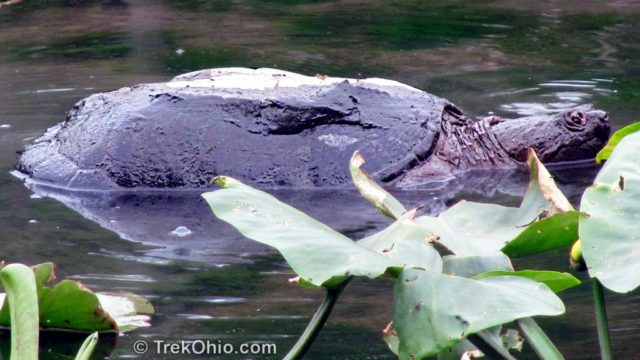
Since 1976 Snapping Turtles have been sighted in the following Ohio counties: Adams, Ashtabula, Athens, Belmont, Butler, Clermont, Clinton, Delaware, Erie, Fairfield, Franklin, Hamilton, Knox, Lake, Logan, Madison, Marion, Medina, Ottawa, Pickaway, Pike, Portage, Preble, Vinton, Warren, Wayne, Williams, Wood. Its historic range includes additional counties.
For more information, check out its Wikipedia page.
Family Kinosternidae
Common Musk Turtle (Sternotherus odoratus)
The carapace (upper shell) of this turtle ranges in length between 2 and 5.5 inches; it has an average weight of 1.33 pounds. It’s most distinctive mark is the yellow stripe near each eye. The “odoratus” in the scientific name is there because these turtles secrete a stinky, yellowish musk when alarmed. They will bite if they feel a need to protect themselves.
Since 1976 Common Musk Turtles have been spotted in the following Ohio counties: Clark, Hamilton, Jackson, Licking, Perry, Pickaway, Pike, Portage, and Scioto. Note that their historic range includes additional counties, so you may see one outside of the counties that I just listed.
These turtles are rarely seen outside of the water unless they are laying eggs. Surprisingly the female may not bother burying her eggs. All that matters to her is that the egg-laying site to be near the water.
For more information, check out its Wikipedia page.
Family Trionychidae
Eastern Spiny Softshell Turtle (Apalone spinifera spinifera)
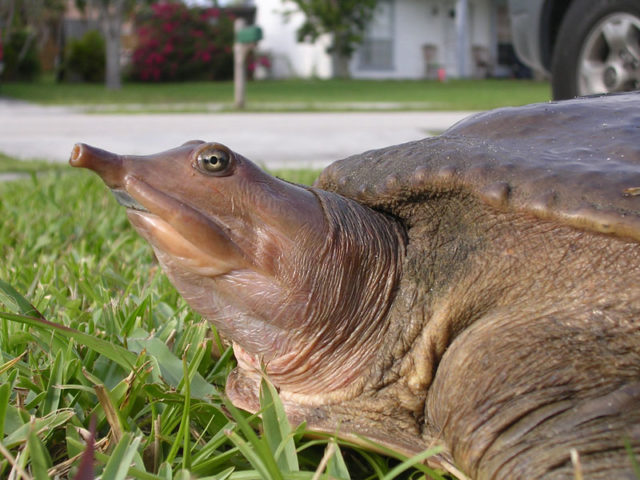
Eastern Spiny Softshell Turtle (Apalone spinifera spinifera) — The little bumps along the front, top shell are the “spines”.
This is another turtle species where the females grow to be much larger than the males. The carapace (upper shell) of the female can attain a length of 7 to 17 inches making it one of the largest freshwater turtles in North America. In contrast the male’s carapace only grows to between 5 and 9 inches. On the leading edge of this turtle’s carapace, there are a series of conical projections under its rubbery shell which is why this turtle is said to be “spiny”. Unlike the Midland Smooth Softshell Turtles, the Eastern Spiny Softshell Turtle has circular spots all over their backs, often with a noticeable ring around the spot.
There’s something about the rubbery shell and the long rubbery-looking snout that makes the turtle seem kind of peaceable. However this turtle is just as aggressive as a snapping turtle.
It is an excellent swimmer; its preferred habitat is the shallow portions of rivers where it will bury its body in sand or mud with just its head sticking out. Surprisingly it can “breathe” underwater. It can pump water in and out of its highly vascular pharynx and extract oxygen directly from the water.
Since 1976 Eastern Spiny Softshell Turtles have been sighted in the following Ohio counties: Ashtabula, Butler, Clark, Clermont, Clinton, Coshocton, Fairfield, Gallia, Hamilton, Licking, Logan, Lorain, Muskingum, Pickaway, Preble, Montgomery. Prior to 1976 it was seen in additional counties not listed here.
For more information, check out the Wikipedia page on Spiny Softshell Turtles. Although this page discusses several varieties of spiny softshell turtles, only the Eastern Spiny Softshell Turtle lives in Ohio.
Midland Smooth Softshell Turtle (Apalone mutica mutica)
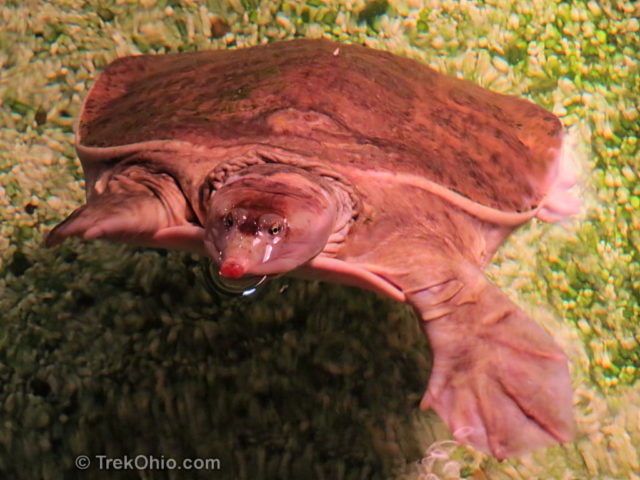
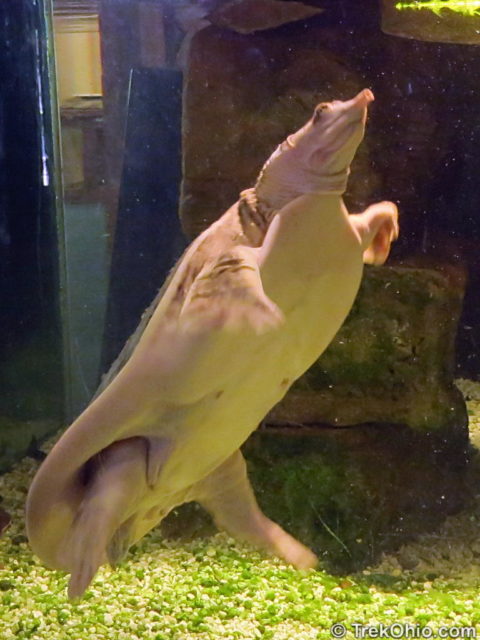
In this species the female is also larger than the male. Her carapace (upper shell) reaches a length of 6 to 14 inches, while the male’s carapace only reaches 4 to 7 inches. Unlike the Eastern Spiny Softshell Turtles described above, the Midland Smooth Softshell Turtles does not have regular, circular spots on its back. What markings it does have on its shell are small, blotchy-looking little things. It likes to live near or on sandbars in large rivers.
Since 1976 Midland Smooth Softshell Turtles have been sighted in the following Ohio counties: Clermont, Hamilton, Muskingum. Prior to 1976 it was sighted in a few other counties not listed here.
Keeping Wild Turtles as Pets
I’ve been getting a number of comments asking about what you have to do to legally keep a wild turtle as a pet here in Ohio. The Ohio Department of Natural Resources (ODNR) describes this process at their website. Once you land on this page, it might not be obvious where to look, but it turns out that you want to click on the tab called Wild Animal Propagation. Here is the relevant information found there as of June 2, 2017.
To keep a wild turtle as a pet, you need to submit an application for a Noncommercial Propagating License which costs $25. According to the ODNR, you may keep up to four individual pets from their list of approved reptiles and amphibians. The website goes on to list four species of wild turtles that are okay to keep as pets. Your pet turtle must belong to one of the following species:
- Eastern Musk Turtle (Sternotherus odoratus)
- Midland Painted Turtle (Chrysemys picta marginata)
- Northern Map Turtle (Graptemys geographica)
- Red-eared Slider (Trachemys scripta elegans)
In general the biggest health concern that people should keep in mind while handling reptiles is being exposed to salmonella (a type of bacteria). It is important to wash your hands thoroughly with soap and water after handling a reptile. There’s an article about salmonella contamination in the Washington Post: Will that pet turtle make you sick?
Here are some web resources that discuss what is involved in caring for a midland painted turtle:
- Austin’s Turtle Page: Care Sheet – Midland Painted
- ReptilesMagazine.com: Painted Turtle Care Sheet
- TheTurtleSource.com: Care Sheet for Painted Turtles
- ExoticPets.About.com: Painted Turtles — includes a discussion of health problems that turtles might have, especially if not cared for properly.
I will note in passing that another visitor, Shelby, left a comment about keeping a midland painted turtle (see her comment here). It sounds like she kept one over the winter, and it was more difficult than she had anticipated.
Additional information
I obtained the county sighting information from a PDF document published in 2008 by the Ohio Division of Wildlife, Reptiles of Ohio Field Guide. The Ohio Department of Natural Resources (ODNR) also publishes a nice overview of our turtle species here. For an interesting, yet easy-to-understand presentation on the anatomy of a turtle’s shell, check out this Wikipedia article.
Jeffrey Davis is a naturalist associated with the Cincinnati Museum of Natural History. He is currently trying to update the location of Ohio’s various species of reptiles and amphibians. To help him get a more accurate understanding of the distribution of these species, Davis needs to see a photo of the animal so he can verify its species. If you are interested in helping him update the official record as to where these animals live in Ohio, you can email a photo of the specimen along with the location of your sighting (be as specific as possible with the location). His address is ohiofrogs@gmail.com. Despite the email address, you can use it to report a sighting of any amphibian or reptile.
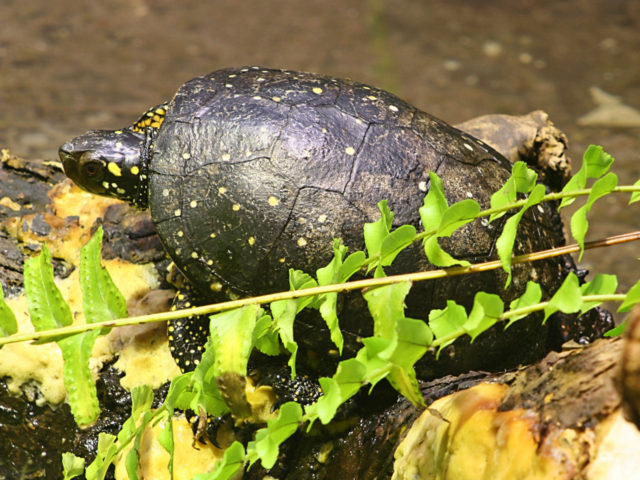
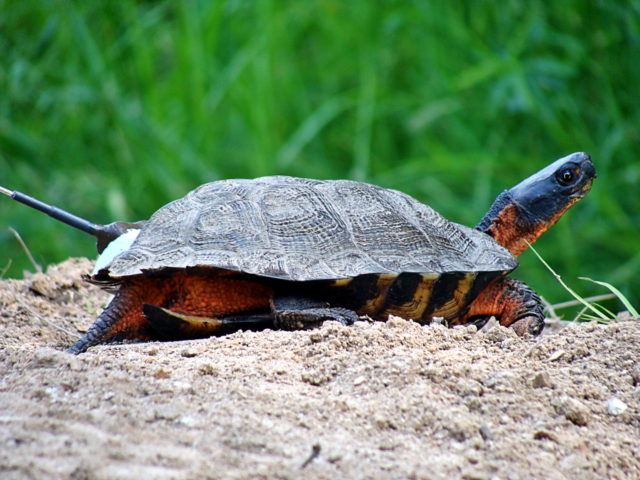
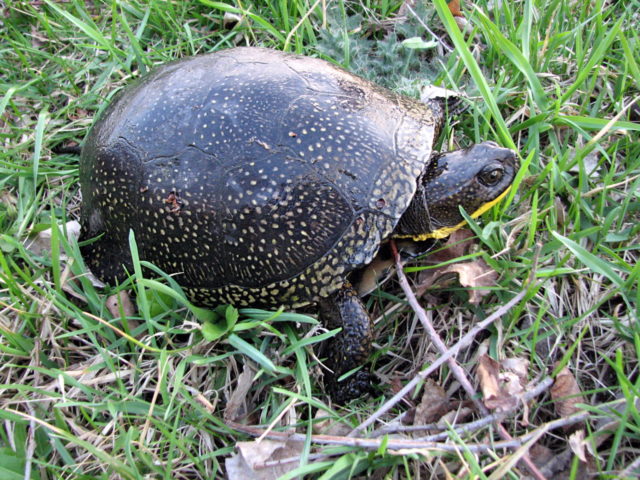
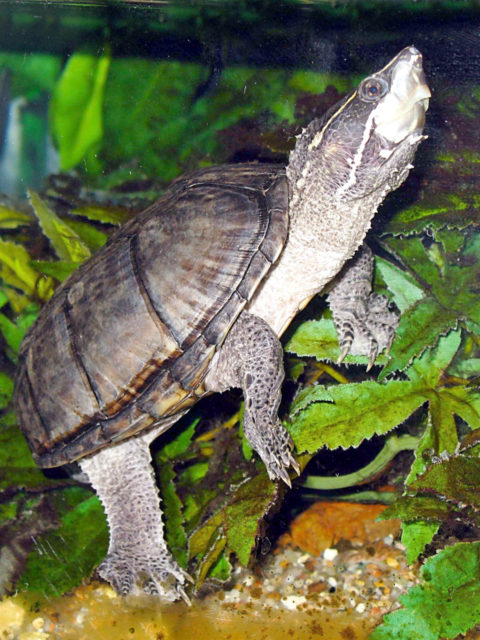
I recentley found a turtle while practicing on Blacklick woods metro parks golf course. I thought it was a piece of bark when i set my bag down but on closer inspection i knew it was a baby snapping turtle. I was positive it was dead since it was not moving. I picked it up and realized its tail moved slightly and figured either someone stepped on it since it was on the golf green or it was cold. I brought it home and have it in a 10 gallon tank with a reptile filter and 3 inches of water with pebbles along the bottom and a couole bigger rocks for it to get out of the water. Last night it ate two earthworms when i fed it. I feel like i need to take the little guy to the nature center at the park so they can display it or release it. I would let it go myself but I’m an animal lover and I’m afraid something will happen to him since it’s the size of a 50-cent piece! I just want him to have a Fighting Chance I know that sounds silly but that’s how I feel!
Robert, I don’t know if you’ve talked to the staff at the Blacklick Nature Center yet, but I’m betting that they would be helpful. I understand what you mean about wanting the little guy to have a fighting chance.
Snapping Turtles are quite come in Jefferson County
fyi, golf courses can be incredibly toxic places – depending on the season rodenticides stupify and kill birds of prey, and herbicides and pesticides accumulate in earthworms and insects and do kill songbirds and probably increase the toxic load on all canada geese, who frequent golf courses as grazing sites.
talk to the management about adopting practices that don’t harm the local wildlife!
I have photos of a spiny soft shell turtle in Apple Creek on the south side of Wooster Ohio (2016);I also caught one as a child in Schellen Park which is near where I photographed the one recently. I think it was nesting near the island by Akron Brass and the railroad over crossing.
We just helped a midland painted turtle across the road today! I picked him up and placed back on the grass away from the road. This was in Clark County, near Springfield. I had never seen a turtle like this and this site helped me ID it. The red on his legs is what I noticed first, when I picked him up. I thought his shell was black, but found out it was just a dark green. Thanks Deb for the article.
Amy, I’m glad that our article helped you to identify the turtle. And good for you for helping it across the road!
We have a midland painted turtle in captivity because my husband found it in a parking lot and brought it home for the kids to see. Of course, the kids wanted to keep it. I believe the turtle should be put back into it’s environment. We have a pond. It’s believed to be about 5′ deep in the middle. We also have wetlands next door to our property, more shallow. I am concerned that there are no other turtles of it’s kind. No fish. We have a lot of frogs. Geese and mallard ducks visit our pond also. My daughter has seen a much larger turtle in our pond but we have not been able to identify it. She thinks it is a snapping turtle. I have not seen it. Do we put it in or near our pond? Or, do we find a natural place at a park where other painted turtles are? Thank you! We live in Aurora, OH
Turtles mate in the spring, so the turtle moving across the parking lot was probably in the process of moving to an area where he/she could encounter the opposite sex. When courtship has been completed, the couple mates underwater. Alternatively if the turtle is a female, she could be on the move trying to find a place to lay her eggs. The female looks for sandy soil to lay her eggs. Older females tend to travel farther away from the water to find a good spot. And experienced mothers tend to use the same spot for a number of years. I would recommend putting the turtle on land near your pond and then letting it go wherever it pleases.
If you decide to keep the animal as a pet, the state requires you to get a license which costs $25. I have discussed keeping wild turtles as pets in more detail in this comment.
My Husband found a turtle in our garage yesterday. It turns out, thanks to this site, that it was a box turtle. I had never seen one in the wild so it was pretty cool..! We returned him outside and before long he was on his merry way.
We live in Lucas county north of Swanton.
I’m pretty sure we found an eaten box turtle here in carrollton oh.
That’s so sad.
I have seen 3 Snapping Turtles in the past 2 weeks along the banks of Holes Creek in Montgomery County (Centerville, OH). In addition, there are at least 5 Eastern Spiny Softshell Turtles in the pond of my apartment complex on Yankee Road in Centerville and one known Snapping Turtle.
THe babies are out! Found a baby painted turtle on the walkway of our back yard in Summit county Ohio.
I found two eastern box turtles behind my house i dont know if she is pregnant but should I keep the. Male and female togeather or should I keep them separate?
Are you trying to keep them as pets?
I have caught a very large snapping turtle. I would say it is 20+ pounds and probably longer than its listed largest size. I am in Morrow county which is not listed. It is extremely aggressive and strong, it looks very old, but in good health. Would anyone be interested tagging it or having me collect specific data? How rare are these in this large size? Would someone be interested in putting it on display for educational purposes?
Jeffrey Davis, a naturalist associated with the Cincinnati Museum of Natural History, is currently trying to update the location of Ohio’s various species of reptiles and amphibians. To help him get a more accurate understanding of the distribution of these species, such as the snapping turtle you mentioned, Davis requires people to email him a photo of the specimen, so he can confirm that its species has been identified correctly. His email address is ohiofrogs@gmail.com
Shelby co. oh. my boys found baby painted turtle.
I told them they’d have to return it to where they’d found it. they’re disappointed. but I don’t want them messing with the local wildlife .
causing an imbalance in the eco system. trying to teach them it’s ok to watch study and explore nature but it’s not ok to disrupt the natural order of things.
do yo know where I can get snapping turtle license
Brian, as I understand it, the Ohio Dept. of Natural Resources allows licensed individuals to keep turtles belonging to one of the following four species:
It doesn’t look like the state wants people keeping snapping turtles as pets.
I would let them go nearby where you found them.
I’m an avid fisherman and when I go to lake Loramie (auglaize, shelby counties) has an abundance of musk turtles. And mercer county (grand lake watershed) has an abundance of snapping, soft shell, midland painter, Eastern maps, and red ear sliders. Just from experiences from fishing. I just wanted to pass the info along to help further your cataloging of the turtles in ohio. Thank you for the sight as it has helped me identify the turtles I or my children catch.
In the past year (2015) I have seen the following in Northern Columbiana county.
1. several midland painted ( largest was about 9″)
2. several snappers ( one was probably 25 lbs and was intimidating to approach)
3. one eastern box turtle
4. a couple red ear sliders ( probably releases or escapes).
WE keep a couple of tortoises as pets, so I am always on the lookout for turtles during my
Spotted a large female map turtle in the Beach City Dam spillway. Tuscarawas County. 8/13/25
The only turtle I’ve ever seen in the wild is the Midland Painted Turtle. I wish I get chances to see more. They are very facinating animals and I’m very interested in them.
I chought one fishing last night here in Ohio and yes it is very beautiful.
Alligator snapping turtles are simply not in our state. The closest proper habitat for them is southern Illinois and extreme western Kentucky. Not certain they are even extant there anymore.
That is to say no wild viable populations. With them showing up at reptile shows, I am certain there will be some releases.
Hercules, thanks for writing. I didn’t think that we had Alligator snapping turtles here. Perhaps the one that Gavin spotted was a released pet.
I have 2 alligator snapping turtles that my son found in our corn field. They are in Ohio.
Naturalists associated with the Cincinnati Museum are trying to update which species of reptiles live in Ohio, and where they are located. If you have a photo of one of the alligator snapping turtles, you can help by emailing it to ohiofrogs@gmail.com — please try to be as specific as possible as to the location of your sighting.
They can be found in Massillon, Ohio along the Tusc.
There are tons (alligator snapping turtles) at Huber heights carriage hill pond metropark
I’ve seen red eared sliders in Vinton County in private ponds. I have had one for 5 years that we saved from death after it was caught on fishing line. We had planned on releasing it back after it healed (hook through its eye), but winter came and it got used to being fed. I’m glad we didn’t release him now knowing they are not an indigenous species.
we didn’t fill our pool this year, and there’s suddenly a painted turtle living in the murky deep end. the nearest river or creek is a mile away across a major road. that’s one intrepid turtle!
The largest turtle in ohio is an alligator snapping turtle i found one in my creek in butler ohio
Everything I’ve read said that alligator snapping turtles live south of Ohio, so I’m glad that you wrote. Very interesting to learn that we have them here!
I think some on this site are confusing the common snapping turtle, the (Chelydra serpentina) with the Alligator Snapping turtle.. Because i do not believe there are any Alligator Snapping Turtles in Ohio.. They do look a lot alike, but the Alligator snapping turtle can get upwards of 200 lbs, and the Chelydra serpentina snapping turtles that are found in Ohio only reach around 30 lbs..
I saw 2 boys poking at a gigantic snapping turtle West of Pioneer, Ohio a few years ago. It’s shell had to be 2×2 feet. Had to be well over 30 lbs.
Midland Paint Turtle found in Delaware County, Sunbury. Size of a quarter and cute. Thanks for the site, was very helpful to identify with my daughter and figure out the best place to relocate it.
I’m glad our site helped. I’ve never seen one so small. The turtle must have just recently hatched. How cute!
I just found a midland painted turtle behind my barn, I live in licking county, ohio. My brothers friend knows a lot about turtles so we asked him to come over, he set up an aquariam and today we are going out and getting food and supplies for it. My mom is worried about any deseases it might carry and if I could catch them. Does anyone know what they might carry?
Cheese Man, you can keep a midland painted turtle as a pet, but the state expects you to buy a license (currently $25 for a non-commercial license). There’s information about the licensing process at this Ohio Dept. of Natural Resources page.
I’ve received a quite a few comments about pet turtles, so I have added a new section to this article on Keeping Wild Turtles as Pets.
Salmonella is very common in wild turtles
Thanks found and identified a baby softshell turtle today while attempting to catch fish lol.
I just saw a giant snapping turtle walking around a parking lot in the rain.
It was absolutely incredible.
I took pictures and video.
I have a 3000 gallon “pond” / fountain with 4 goldfish that became 120 goldfish. I’d like to install a native predator, either turtle or frog, to reduce the number goldfish. Obviously I don’t want to dump them. The pond is filtered and deep enough for winter freeze. Any suggestions? Thanks
Having frogs wouldn’t help. Snapping turtles do prey on fish. But the downside of this approach is that you would now have a snapping turtle in your pond (if it stayed… it might walk away).
Here’s a video of a snapping turtle eating fish in an aquarium (in the wild they use a different approach, burying themselves at the bottom of ponds and ambushing fish that go by):
https://www.youtube.com/watch?v=bLxD1Dyrk_c
I have a friend whose ornamental pond was stripped of all its fish by a heron. Too bad there is no way of encouraging one to stop by your pond.
If you put a predator in, that few amount of goldfish would quickly become 0 goldfish if those were the only prey available in the pond.
If the fish arent too big big, say less than 8 inches, they’d make good bait for catfishermen.
Best control for pond overrun with goldfish is a bluegill. I had the same problem in my decorative pond (~ 1200gal.) until I added a little guy. Soon grew to big guy!
This is a very helpful page. I’m just south of Zanesville in Muskingum County and found a Midland Painted Turtle in my yard. There is a lake nearby so I’m not sure why this turtle climbed up a hill away from the lake and close to a road. It was about the length of an adult hand, and was a little retracted into the shell when I saw it. Thanks for the info.!
Melinda, I’m glad this page helped you to identify the turtle that you found.
from Westerville-about a decade ago I found a hatchling snapper in the side access road of a parking lot strip mall by a run off of Alum Creek, raised and released in same vicinity, removed an adult (the size of the bottom of a 33 gallon trash can) from the yard of a friend who lived in uptown, released in Hoover same day. Last week found what looked like a dirt clod, the size of a quarter, on the cement at work-map turtle hatchling, to be raised and released-will not be exposed to any creatures from pet trade-both the snappers I mention were of the “gator” variety, not the ones commonly seen here
There are definitely snapping turtles in warren county too like all over the place. If anyone was thinking they might have seen one there, you probably have.
I grew up in lake county right next to the mouth of the chagrin river and have caught and seen quite a few softshells in my neighborhood. Is this something I should notify someone about? It’s a watershed area, might need to look into conservation.
I just found a midland painted turtle in my yard. I live in Medina. He is no bigger than a quarter. The plan was to show my granddaughter and her friends then release him in a creek. After reading that the survival rate of baby turtles is very low I am not so sure I want to release it.
Marcella, it is legal to keep a midland painted turtle as a pet, but the state expects you to buy a license (currently $25 for a non-commercial license). There’s information about the licensing process at this Ohio Dept. of Natural Resources page.
I will note in passing that another visitor, Shelby, just left a comment about keeping a midland painted turtle (see her comment here). It sounds like she kept one over the winter, and it was more difficult than she had anticipated. You could try hitting the “Reply” button directly under her comment, then asking her for more information on what those difficulties were.
At any rate I’m sure that your granddaughter and friends will enjoy getting to see the little fellow.
I live in Holmes County, and I disagree with the official record of turtle distribution too. We have snapping turtles, and red ear sliders out the wazoo here. Probably others as well. Bicycle down the trail from Walmart a mile or two, and you’ll find them. Also in the marshy areas along 62 going to Killbuck. Across from where the rest area used to be.
I have a Midland Painted Turtle that I saved from getting hit by a semi last summer. At the time I didn’t know you couldn’t take them from the wild and I learned why. But I can’t keep up with his needs and was wondering when they come out of hibernation. My cuz has a large pond I could put him in with other Midlanders But I don’t want to put him in there if its not safe from freezing yet. Could you help me out please?
Shelby, I have been seeing Midland Painted Turtles basking in the sun already in central Ohio. I think it would be safe to release him now.
Thank You! 🙂
Just wanted to say that I have seen snappers in 3 counties not listed on the sightings list in just the last 5 years. Gallia, Jackson, and Hocking
Kyle, thanks for pointing out that the range for snappers is bigger than the official records seem to indicate.
Washington county is not listed either and I have seen many snapping turtles here.
Thank you for the pictures and information on this site. It helped me identify a turtle I saw in the woods as an Eastern Box turtle. I saw it in Muskingum County, a little south of Zanesville.
Wonderful and very long lived critters. We’ve been fortunate to see several on our trips through Ohio.
Just had what I believe to be a baby red-eared slider crawling across our driveway, and headed to our garage.
I grabbed 3 pictures, then set it out back in our yard away from any place he/she might get hurt. Haven’t seen it again since. I live just outside of West Mansfield, OH. I can send the pictures if you’d like.
Patrick, I wouldn’t be surprised if that’s what it is. It seems that red-eared sliders are moving into more and more counties. If you’d like to send a photo, we have a gmail account under the name trekohioblog.
I reside in Hamilton County and have caught many snapping turtles out of both the Ohio River and a local creak near where I reside. I used to catch Eastern Box Turtles every single time I hunted them here in Hamilton County when I was a kid. I would catch them, feed them for a couple of days and then let them go back in the woods. Cant find any now though. Every so often I take my son looking for them and it seems like they are all gone. They may be endangered by now I guess.
I live in Lucas county Ohio and your article mentions snapping turtles in other counties and not Lucas. I know positively that they are quite prevelant as I had the priviledge of observing 3 large females come up the water into a grassy area, dig and dig and lay their eggs. I feel for me this encounter was probably a once in a lifetime experience and was July of 2013. I have been going back to same spot this year with no luck.
Spotted a 14″ snapping turtle in the back yard of our under-construction house in Liberty Township, Butler County around June 1, 2014. I think it was a female preparing to lay eggs in a dirt mound created by the construction. Knowing the eggs would not survive there I tried to encourage her to move along. Of course she got aggressive, but I was able to stay away from the sharp end. I was surprised to see her there since we’re at least 0.5 mile from the nearest significant creek.
I’m not sure why it isn’t listed, but the common snapping turtle is found throughout Gallia county. I help them across the road at least two or three times every early summer. I’ve even see a few hatchlings from time to time.
Daryl, I’ve seen turtle species outside of the listed counties, too. I think the best way to regard the counties listed per species, they were a snapshot of how things were when ODNR published this data.
Last week I found a very large turtle on the road in
front of my home in Spring Valley, Greene County,
Ohio. The turtle shell was approx. 14 “long and he was cranky. Luckily a neighbor was able to pick him
up by his huge tail and toss him into the woods and off the road. Thank you Dennis.
I just found a Midland Painted Turtle (Chrysemys picta marginata) in our yard, we live in Carroll County. I comment this since we were not one of the counties listed that these are found in. 🙂
Interesting! Thanks for posting, Kathe.
Saw a huge snapping turtle from the middle of the street in a heavily traveled area. Wasn’t going to pick it up but luckily, a van with two men finally stopped. He picked it up by its tail and walked it across my company’s yard and deposited the turtle in our beautiful pond. We have an array of nice fish (and lots of frogs) in that pond. I feed the fish. Do I need to worry about the turtle eating our fish? Could the turtle have eggs? I certainly would not want to it to deposit them in our pond. Is there a way to get that turtle out of the pond?
In the Wikipedia article on snapping turtles (Common snapping turtle – Wikipedia, the free encyclopedia), it says:
So it would appear that your pond’s new snapping turtle may end up eating some of the fish and frogs in your pond.
Snapping turtles do not lay eggs in the water; instead they find a patch of sandy ground where the female digs a hole, lays her eggs, then buries them. The one in your pond may or may not be female.
If you have unwanted wildlife on your premises, there are organizations that you could contact to move them off your premises. For instance, in central Ohio there is an organizations called, the Ohio Wildlife Center (their Facebook page is here). I believe the Ohio Wildlife Center has a subsidiary organization, SCRAM! Wildlife Control that claims to humanely removed unwanted wildlife (note: I have never used their services, and I don’t know what, if anything, they charge for their services). If you don’t live in central Ohio, there are probably similar orgranizations where you live.
Just found a snapping turtle away from water in our yard in Summit County. 5/18/14
I like your page its cool to check it out. I have a few of the turtles listed here living with me. Red Ear Slider, Painted Turtle, and the Eastern Box Turtle who lives in the same habitat as my painted turtle. They are a like two peas in a pod. The only one I have that’s on here is the a Snapping turtle its not one on here. Love the page.
my husband found me the little baby turtle and i am trying to identify type but its hard . this is helpful for adult tutles but sure would like to see baby pics of these types so i could tell
Very informative! I came to this site just to see if the turtle I found on my front lawn yesterday was native to Ohio or someone’s escaped pet, lol. Luckily, what I found was a Midland Painted turtle. I took him to the nearest park and let him go near the river. I didn’t want him to get injured or attacked by a dog in our residential area.
just found a Midland Painted Turtle in my back yard (Wood County, Ohio) while mowing. Relocated him to the ditch.
I have a great picture of a midland smooth soft shell turtle which is in my yard right now in Washington County Ohio. Its shell is 6 inches, so I take it that it could be either male or female?
The carapace length does seem to be in the range for either gender. If you have uploaded the photo to a site where you could share the URL with me, I’d be interested in seeing it.
I think I have seen some common map turtles this week across from my house on the Scioto River in Radnor (Delaware County) I did get some images I think with enough information to identify. Your commentary on these turtles states we are out of their normal sighting range? I’d be interested in sharing these images to confirm.
We live in Huron County and have numerous snapping turtles and box turtles. Today saw a smooth turtle. Looks like a eastern spiny but not sure Took a photo and a little video. Any ideas where we can send it for ID
I would love to see smooth turtle, so I’m a little bit envious.
If you have a Facebook account, there is a group called “Herping Ohio” (https://www.facebook.com/groups/herpingohio/). You would have to request to join the group, but after getting in, you could post a photo to the group’s page and ask for help identifying it.
Alternatively if you have a Flickr account, there is a group called, “Flickr: Ohio Wildlife ID and Appreciation” that might be able to help.
If you do upload it to some site on the web, I’d be interested in its URL so I could see it, too (if it’s not too much trouble).
Best wishes in your search for its identity!
We just had a snapping turtle cross our road from one wetland area to another in Richland county. I have a picture if interested.
I would be interested in seeing it, Jon. Have you uploaded it to some place where you could share the URL?
I have seen snapping turtles in Cuyahoga National Park (Cuyahoga & Summit counties).
I’ve also seen turtles in Ohio counties that are outside of their official range. At one point I found a page on the website for the Department of Natural Resources where you could report species sightings (sorry, I don’t remember where). However, when I filled out the form, that was that. I don’t know if it was of any use or not. There was no feedback.
ive ben catching eastern spinys and snappers in summit county also caught a quachita map turtle last year it was a baby no more than 1 month old
Craig, those are great examples of turtle species living outside of their expected counties in Ohio.
I’d love to see a baby Quachita Map Turtle. The spines along the ridge on their top shell are supposed to be really pronounced.
GREAT post! I’ve always wanted to do something similar on our FLA turtles, but I can never get decent close-ups. Fantastic information though, and I love how it’s all in one place…. This really should go into your area’s news resources, nature journals, etc. Have you thought about submitting?
That Eastern Spiny looks so unusual! Very interesting feature!
Great quick reference for turtles! We recently saw someone pull a 35 lb snapping turtle out of a local boat lagoon. Don’t often get to such a big one up close. It was not happy and the fisherman was planning to release it once he figured out how to free it from his hook 🙂
That’s quite a story about turtles! I think turtles are such cool creatures. We had a box turtle as a pet when my daughter was young, named Sally. Thanks for all the information and the great photos… 🙂